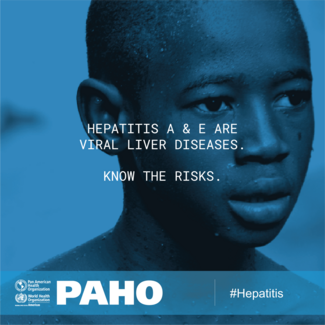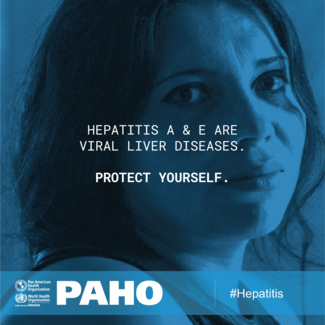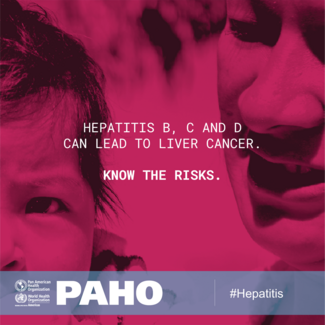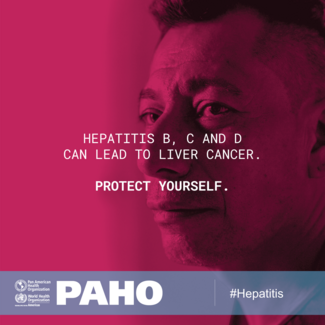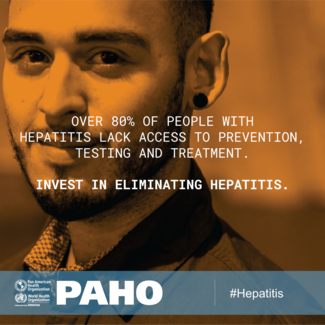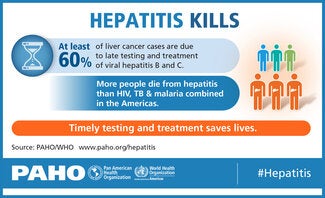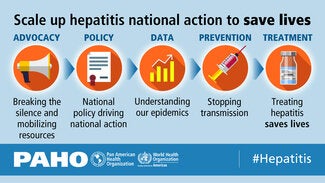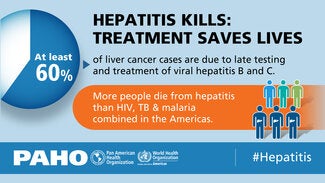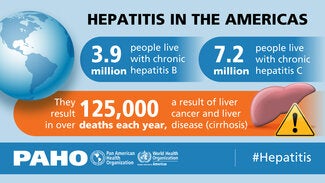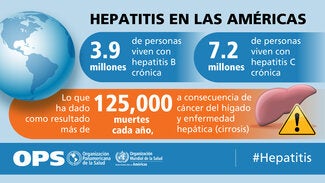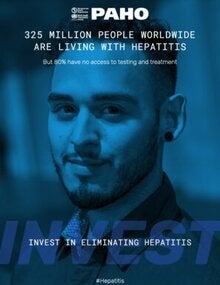28 July 2019
World Hepatitis Day
This year, WHO is focussing on the need for increased financing for hepatitis prevention, testing, treatment and care services in the context of universal health coverage (UHC) with a slogan “Invest in eliminating hepatitis”. This campaign can help to achieve the following objectives:
- To urge national and regional policymakers increase political and financial commitments for hepatitis response
- To highlight WHO’s new costing estimates for hepatitis elimination within the context of health-related Sustainable Development Goals (SDGs) and UHC by 2030
- To encourage people come forward to access hepatitis prevention, testing and treatment services
More information
For World Hepatitis Day 2019, WHO is focussing on the need for increased financing for hepatitis prevention, testing, treatment and care services in the context of universal health coverage (UHC) with a slogan “Invest in eliminating hepatitis”. The campaign can help to achieve the following objectives:
- To urge national and regional policymakers increase political and financial commitments for hepatitis response
- To highlight WHO’s new costing estimates for hepatitis elimination within the context of health-related Sustainable Development Goals (SDGs) and UHC by 2030
- To encourage people come forward to access hepatitis prevention, testing and treatment services
WHO plans to participate in special events organized by the Government of Pakistan on 27-28 July commemorating World Hepatitis Day 2019. The events will include the WHO Regional Director for the Eastern Mediterranean and Assistant Director-General for UHC/Communicable and Noncommunicable Diseases.
All WHO regional and country offices are strongly encouraged to engage ministries of health and partner organizations in jointly commemorating World Hepatitis Day 2019.
We note that the World Hepatitis Alliance, one of our key partners and a global umbrella organization of patient advocates will be promoting “Find the Missing Millions” campaign launched in 2018. The campaign's focus on hepatitis testing and diagnosis addresses a major barrier in achieving elimination, and is consistent with the overall advocacy goals.
We recommend designing campaign messages, materials and events for the following target audiences, who have specific roles in bringing change to the viral hepatitis response.
- Policy-makers: This audience includes high-level decision-makers such as presidents, prime ministers and ministers of health, and related sectors such as finance, education and labour. Health sector workers such as programme managers are also regarded as policy-makers, as they shape and influence policies that affect the lives of people living with hepatitis.
- General public: One of the main objectives of a world day dedicated to viral hepatitis is to promote public awareness and education. Activities should use simple, accessible messages and products to inform affected people, and to encourage everyone to demand hepatitis prevention, testing and treatment services.
- Health workers: As one of the groups most vulnerable to hepatitis B infection, health workers are recognised as a special audience. They also play a key role in the delivery of prevention, testing and treatment.
- Media: High burdens of viral hepatitis around the world highlight a lack of global visibility and partnerships. WHO recommends mobilizing wider media coverage and engagement by various global, regional and national partner organizations in the response to viral hepatitis.
- Partners: Eliminating viral hepatitis requires strong global, regional and national partnerships. So far, there have been very few international donor agencies investing in viral hepatitis activities globally. The significant support of Unitaid should be noted. World Hepatitis Day 2019 provides a good opportunity to showcase inspiring work led by countries and communities, and advocate for the engagement of more partners.
Information included in this brief aims to orient WHO representatives and staff in planning their communication activities. It is also very important to engage the people affected by and living with hepatitis in all campaigns and events. Messages and products included in the brief are indicative and should be revised and re-designed in discussion with communities, to reflect country and regional needs.
3.1 Top 10 messages for policymakers
- Viral hepatitis B and C is a leading infectious killer, yet the majority of global leaders and the public remain unaware. Viral hepatitis B and C affect 325 million people worldwide, leading to about 1.4 million deaths a year. It is the second major killer infectious disease after tuberculosis, and 9 times more people are infected with hepatitis than HIV. Deaths from hepatitis have been increasing over the past 2 decades, which points to a lack of global awareness and action, including among top decision-makers.
- Despite this situation, much can be done: hepatitis can be prevented, diagnosed, treated and managed well. The hepatitis B vaccine is 98-100% effective in preventing new infections. For hepatitis B, people should be tested and if found positive and eligible , provided with lifelong treatment. For hepatitis C, people can be cured with a simple 2-3 month treatment with direct acting antiviral (DAA) drugs.
- However, most of the people living with hepatitis--over 80%--lack access to testing or treatment. Among people living with hepatitis B, only 10% (27 million) knew their infection status in 2016. Of these diagnosed people, only 17% (4.5 million) received treatment. Among people living with hepatitis C, 19% (13.1 million) knew their infection status in 2017, of which 15% (2 million) received cure in that same year. Overall, between 2014 and 2017, 5 million people have received hepatitis C cure worldwide.
- At the same time, people are becoming newly infected due to a lack of prevention services. In 2017, 1.1 million people were newly infected and developed chronic hepatitis B infection and 1.75 million people developed chronic hepatitis C infection. Together, hepatitis B and C account for the highest number of new infections from among other major infectious diseases such as HIV and tuberculosis. Improved harm reduction, blood and infection control services and hepatitis B vaccination efforts are urgently needed.
- Achieving hepatitis elimination by 2030 will require a major increase in funding for hepatitis prevention, testing and treatment services as part of achieving universal health coverage (UHC).
- A new WHO costing analysis underlines that an additional funding of US$ 6 billion per year will be needed in low- and middle-income countries (LMIC) between 2016 and 2030, in order to achieve hepatitis elimination targets. The analysis is aligned with WHO’s SDG Health Price Tag from 2017. Only US$ 0.5 billion were invested in 2016, and this sum primarily consisted of domestic financing.
- Countries need to ensure that national hepatitis testing and treatment plans include dedicated funding and investments.
- As of April 2019, 124 countries have developed, or were developing, national hepatitis plans and strategies. But many of these plans lack funding. In 2017, only 58% of the 82 reported LMIC had included domestic funding in their national hepatitis plans. Greater progress is possible when countries invest in hepatitis testing and treatment services.
- Countries should seek most optimal prices for medicines and diagnostics.
- WHO’s new analysis shows that hepatitis testing and treatment are high-impact interventions that can help countries accelerate progress towards UHC. But prices for medicines and tests are very uneven and they can be very expensive in some countries. For example, hepatitis C medicines can cost as high as US$120 000 in some high-income countries. But in Pakistan the same curative treatment can be obtained at US$15. Countries and partners need to work together to achieve the most optimal prices for hepatitis drugs and diagnostics to make access possible for more people.Investing in hepatitis is a smart decision for broader health outcomes.
- Investments in hepatitis elimination would lead to a 1.5% increase in the global health price tag, but such investments would bring greater returns on better general health outcomes. Funding hepatitis testing and treatment services as part of UHC efforts can cut global deaths by 5% and increase healthy life years by about 10% by 2030.
- Investing in hepatitis testing and treatment means preventing liver cancer. Chronic infections of hepatitis B and C viruses may not show symptoms for a long period, sometimes years or decades. They slowly and silently damage the liver, eventually causing cancer. Over 60% of liver cancer cases are due to late testing and treatment of viral hepatitis B and C infections. Two thirds of these cancer cases are caused by hepatitis B, and one third by hepatitis C.
- On World Hepatitis Day 2019, join the cause to help 325 million people. Stop ignorance and neglect of viral hepatitis – share information about it. Educate yourself and others to learn risks for viral hepatitis, and access testing services. If you have been diagnosed with hepatitis B or C, speak with health workers about potential treatment, monitoring or curative therapy. If detected early, the risk of chronic illnesses and financial burden for you and your family can be averted. Take action today.
3.2 Key messages for public awareness campaigns
Are you at risk? Know hepatitis today.
- Are you at risk – get tested.
- Early testing means early treatment to prevent illness and to save your life.
Are you protected from hepatitis?
- Hepatitis B and C are preventable.
- Every injection should be safe.
- Hepatitis B vaccine provides lifelong protection.
- Hepatitis B and C can be transmitted by sex, therefore protect yourself by using condoms.
Be strong: get treated and for hepatitis C you can be cured.
- If you tested positive, ask whether you need treatment – do not delay.
- Living with hepatitis B? Some people will need treatment and can stay healthy with life-long therapy.
- Living with hepatitis C? 3-month treatment can cure the infection.





